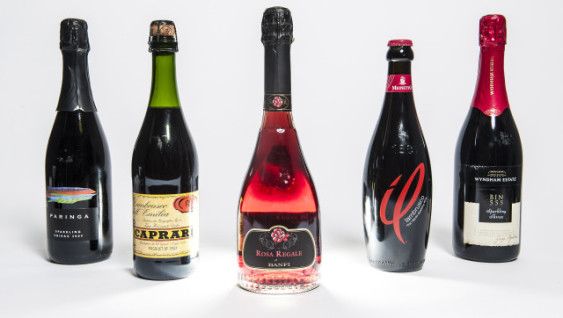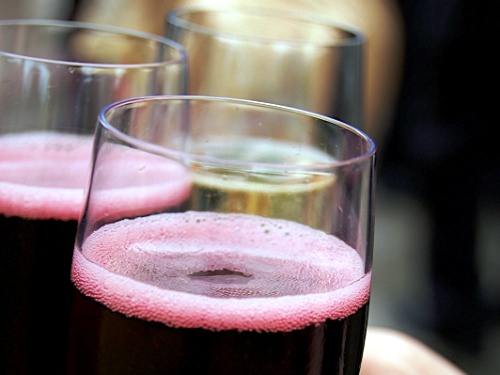While the vast majority of sparkling wine, including Champagne, Prosecco and Cava, is white (with some rosé thrown in), there are actually a lot of sparkling red wines out there, and they’re worth getting to know.
Though the champagne-soaked festivities of the holidays and New Year’s are well behind us now, that doesn’t mean you should forget about sparkling wine for another whole year. Instead, have a look around for sparkling reds, whose effervescence keeps things light, but whose heft makes them hearty enough to drink this winter.

There are several kinds of sparkling red wines to try – start popping those corks! Image source: Huffington Post. (Damon Dahlen, AOL)
Lambrusco: This is probably the world’s most famous sparkling red wine, and is made from the grape of the same name (though there are actually a few varieties of it). Unfortunately, due to some mass-produced versions, a lot of folks have some bad associations with it, finding it to be sugary and indelicately fizzy. However, the styles range from sweet to bone-dry (secco), so there’s something for everyone. In general, the higher the alcohol level, the drier the wine will be, so if you want to stay away from the saccharine side of the spectrum, look for Lambruscos with an alcohol content of 10% or more.
Lambrusco comes from the Northern Italian region of Emilia-Romagna (the major town here is Bologna). Emilia-Romagna also happens to be one of the country’s most important foodie bastions, home to Parmigiano-Reggiano cheese, Balsamico di Modena vinegar, Prosciutto di Parma and various pasta including tortellini. So yeah, they take their wine seriously, too. The reason they drink Lambrusco is that the flavors and body of the red wine will hold up against their famous foodstuffs, but because it’s sparkling, its acidity cuts through the richness of the cuisine. Try Fattoria Moretto Lambrusco Secco.

Lambruscos vary from dry to sweet – try a few for yourself! Image source: Concorso Lambrusco.
Sparkling Shiraz: Australian producers have been making sparkling Shiraz for decades now, but it’s managed to remain under-the-radar for the most part. Luckily, that’s been changing, with more wine stores and even grocery stores in the US beginning to stock it. These wines have all the substance of their flat counterparts, including dark, purply fruit flavors, spice and oak-imparted flavors, but with the lightness of an effervescent wine that makes them more food friendly. Have a bottle with barbecue, or rack of lamb. Try The Chook Sparkling Shiraz.
Brachetto d’Acqui: A lesser-known Italian sparkling red, this one comes from the Piedmont region in northwest Italy and is generally very sweet, with a low alcohol content and lots of residual sugar. However, it still has a fairly high acid content that keeps it from being cloying. Pair it with a dark-chocolate dessert or a sharp cheese. Try Marenco Brachetto d’Acqui Pineto.

Try some sparkling Shiraz for variety.
Bugey-Cedon: Bugey is a little region in the southeast of France near the border with Switzerland where they make sparkling reds from grapes that are generally better known in other French regions: Gamay, which you’ll find in Beaujolais, and Poulsard, which is from the Jura. Slightly sweet, these wines are generally pretty plucky and vibrant, making them a great accompaniment to the rich, creamy cheeses of this region. The other fun fact about these wines? They are made according to what is called the méthode ancestrale, which is thought to predate the method used in Champagne, and in which the wine is bottled before all its residual sugar has been converted into alcohol so that the end of fermentation takes place in the bottle and results in a sparkling wine with no added sugar or dosage to round off the acidity. Try the Patrick Bottex “La Cueille” Bugey Cerdon Rosé.

